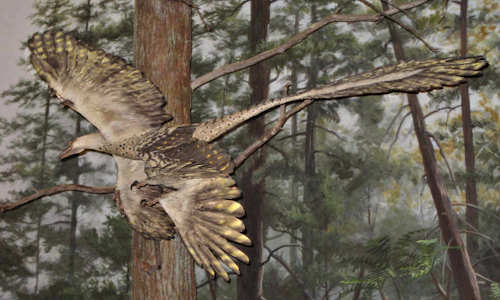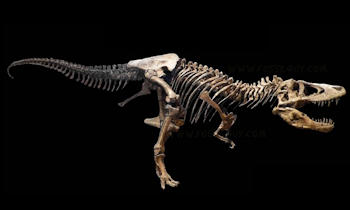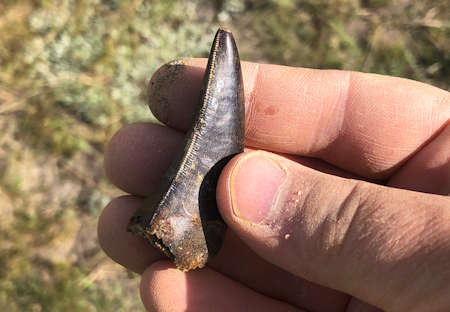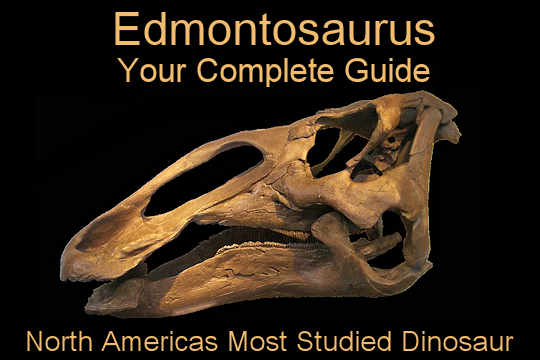Article written by: Jayson Kowinsky - Fossilguy.com
Dromaeosaurids - The Raptors
Introduction to the Raptors

Size chart of different well known Dromaeosaurs: Microraptor gui, Velociraptor mongoliensis, Austroraptor cabazai, Dromaeosaurus albertensis, Utahraptor ostrommaysorum, and Deinonychus antirrhopus. Image Credit: Fred Wierum (CC BY-SA 4.0)
The Dromaeosaurids are a family of Cretaceous feathered theropod dinosaurs made famous by the 'Velociraptors' of Jurassic Park. They are often nicknamed raptors, and well-known ones include Dromaeosaurus, Velociraptor, Utahraptor, and Dakotaraptor.
Although Jurassic Park Franchise depicts Dromaeosaurs, such as Velociraptor, as lizard like monsters, they were far more bird-like than lizard-like. This is because birds and Dromaeosaurids share a common ancestor in the early Jurassic. Shared characteristics include hollow bones, flight feathers, wings, a stiffened tail, body design, and even a wish bone. In fact, they are so similar that these theropods along with Troodons are grouped together with birds in the Paravian clade.
In general, raptors are bipedal with legs and bodies built for speed and agility. Their arms are long, fully feathered, and closely resemble bird wings, and their tails are stiffened with tendons. Together the long tail, used for counterbalance and the wings, used for stability, would make them highly agile and maneuverable. In fact, raptors only used 2 of their 3 front toes to walk and run which implies nimbleness (the remaining toe housed a large retractable claw). They also have forward facing eyes for good stereo vision. To accommodate their extra motor skills and superb vision, their brains were relatively larger than other dinosaurs (but still much smaller than mammal brains). Raptors were fine-tuned predators.
Most raptors were very small, around the size of a turkey. However, a few Dromaeosaurs grew taller than a person. Examples of these larger Dromaeosaurs include Utahraptor and Dakotaraptor of the North American Cretaceous.
Almost all of the small Dromaeosaurs used their wings and claws to help climb trees. Many were either arboreal (climbing and/or living in trees), while some were even volant (flying and/or gliding from tree to tree). One of the more famous flying Dromaeosaurs called Microraptor gui had 4 wings and a tail that could generate lift! To learn about the flying Dromaeosaurs, check out my flying dinosaurs article.

The left image is a typical pop culture Jurassic Park style raptor. JP used Deinonychus as a rough base for their 'Velociraptors' as true Velociraptors are about the size of a turkey. The right image is the scientifically accurate version of Deinonychus. Right image is by Emily Willoughby (CC BY-SA 4.0)
Feathers
Raptors were fully feathered, including wings.

Life reconstruction of the raptor Dineobellator notohesperus depicting a possible scene from the Maastrichtian (approximately 66.5 Ma) in the San Juan Basin, New Mexico.
Image Credit: Sergey Krasovskiy - From the Penn State news release (CC BY 4.0).
When paleontologists say raptors were feathered, they don’t mean a lizard looking animal with a few scruffy feathers. Dromaeosaurids were FULLY feathered, like a falcon, including long feathers on their wings and elaborate tail feathers.
How do we know this? For more than 20 years there have been exceptionally preserved dinosaurs coming from the Liaoning Province of China. These fossils have soft tissues and feathers preserved. Quite a few Dromaeosaurs have been found in these fossil layers and they are completely covered in feathers. They look like birds!
More recently in this province, a larger - approximately 1.6-meter - Dromaeosaurid called Zhenyuanlong suni was discovered (Lu and Brusate 2015). Except for the legs, this specimen is also fully feathered, complete with long feathers on its wings. This lends support that even the larger Dromaeosaurids were fully feathered.

The holotype of the large-bodied, short-armed Liaoning Dromaeosaurid Zhenyuanlong suni gen et. sp. nov. (JPM-0008). Notice the preserved feathers. Image Credit: Figure 1 from Lu and Brusatte, 2015 (CC BY 4.0)
Outside of the Liaoining Province, where dinosaurs don’t have soft tissue preservation, we can still tell they had feathers by looking at their bones. Bird bones sometimes have quill knobs, or bumps, on their ulnas (arm bones) that serve as anchor points for secondary feathers. Well-preserved Dromaeosaurid arm bones have these same quill knobs. Good examples of preserved quill knobs on larger Dromaeosaurids include Velociraptor of Mongolia (Turner et al, 2007), Dakota Raptor of South Dakota (DePalma et al, 2015), and Dineobellator of New Mexico (Jasinski et al, 2020). All of these Dromaeosaurids have quill knobs on their arms, indicating fully feathered wings.

This figure shows the quill knobs on A: Dakotaraptor, B: Velociraptor, C: Concaneator, and E: a modern bird. D is a reconstruction of Dakotaraptors wings.
Image Credit: Figure 4 from DePalma et al., 2015 (Open Access)

A digital reconstruction of a Dakotaraptor wing and what it may have looked like with attached feathers. Image Credit: Robert DePalma - 2015.
The Killing Claw
It wasn't really a Killing Claw

The foot of Deinonychus (MOR 747), a raptor from the Cretaceous of Montana. Notice the retracted 'Killing Claw' on the second toe. Image Credit: James St. John (CC BY 2.0)
All Dromaeosaurids have an unusually large sickle-shaped foot claw on their second toe. This claw was normally retracted and held off the ground while walking, and, if needed, could swing downward into prey. This claw is so prevalent in pop culture, that it has a nickname; the “killing claw.”
It’s common to see depictions of raptors jumping on the sides of a large dinosaurs, grasping with their arms and slashing through flesh with their killing claw. These gruesome scenes play out in the mind of many dinosaur enthusiasts, but how accurate is this? Did Dromaeosaurids use their killing claws to slash into and disembowel larger prey?
To the dismay of many Jurassic Park fans, the answer is no. Manning et al. modeled the hind limbs of Dromaeosaurs and found the killing claw is not at all effective for slashing (2006). Even though they tried using it to slash flesh, the claws would simply pierce but not tear. In fact, they would break when attempting to tear into thick hide. A different study by Peter Bishop modeled the forces produced by raptors' feet and claws in various positions and leg postures (2019). He found the force produced from the claw tip was actually quite small. Both of these studies concluded the claws were used more for grasping and pinning smaller prey.
In 2011, Fowler et al., looked at the overall hind limbs and forelimbs of raptors to determine their feeding style. They concluded the claw was most likely used to grasp and hold on to smaller struggling prey. Their feathered forelimbs were not used to help grasp prey, but would instead flap to maintain stability while pinning down prey. This feeding style is remarkably similar to birds of prey, where they pin down smaller prey with their claws, flap to maintain control, and feed with their beaks. The only difference is raptor jaws contained numerous small serrated teeth that acted like small steak knives!
-Emily-Willoughbyweb.jpg)
Reconstruction of Deinonychus antirrhopus engaging in the prey restraint model of predation suggested by Fowler et al in 2011. Prey here is Zephyrosaurus, a hypsilophodontid. Image Credit: Emily Willoughby (CC BY-SA 3.0)
Cooperative Pack Hunting?
Probably not

Nope... Didn't Happen...
This display, at the Urweltmuseum Hauff, shows a pack of plucked Deinonychus attacking a family of Iguanodons. Research shows they did not hunt in coordinated packs, and were most likely solitary. Research also shows they did not use their "Killing Claw" to climb and slash large dinosaurs, as they most likely hunted smaller to similar sized animals. Image Credit: Angela Marie Henritte (CC BY 2.0)
So, the killing claw wasn't used to slash and gut large prey. How about pack hunting? Did raptors cooperatively take down large prey? To the dismay of Jurassic Park fans, the evidence also suggests they did not.
Raptor pack hunting behavior was proposed by Ostrom in the late 60's when he discovered and studied Deinonychus. Ostrom found these raptors alongside Tenontosaurus specimens and suggested Deinonychus actively hunted these dinosaurs in groups. However, more recent research has dispelled this and found these fossil sites are most likely scavenging sites, where raptors scavenged both the Tenontosaurus carcass and its own species.
Other discoveries show multiple raptors preserved together. But, this isn’t necessarily evidence of social activity either. A good example is the Utahraptor megablock, which preserves many Utahraptor individuals with a larger dinosaur. This is often considered a classic predator trap analogous to the La Brea Tarpits, where a dinosaur becomes stuck in mud/quicksand and individual raptors scavenge upon it and become trapped themselves.
In 2009, Roache and Brinkman explored this question at length. They found evidence of intraspecies aggression between raptors (one raptor killed another) and also through phylogenetic inference concluded these theropods were “solitary hunters or, at most, foraged in loose associations.”
Later, in 2020, Frederickson et al. took a different approach to this question. Social animals that hunt together feed their young, while asocial animals do not. This means the diets in young social animals are the same as in adults, but are different in asocial animals. The change in diet of asocial animals can be detected in the oxygen and carbon isotope shifts in their teeth. Frederickson et al. found the isotope ratios in young and adult Deinonychus teeth were supportive of asocial animals and were, in fact, very similar to crocodilians. This indicates Deinonychus did not feed their young, so they may not have lived in social groups or hunted in packs.
The only evidence for social behavior was found in 2007. Li et. al. studied a set of 6 trackways made by a group of Dromaeopodus raptors. The trackways were made within a very short time and show the dinosaurs walking in the same direction. This discovery at least indicates there 6 raptors walking in a coherent group together. This does not mean they were pack hunting or walking in a family group. They all may have been simply heading to a carcass. The exact reasons for walking together may never be known.
One final issue is their brain size. Although raptors had relatively larger brains compared to other dinosaurs, they were still small in comparison to mammals and their anatomy is more like a crocodile brain. Cooperative pack hunting takes intelligence, which mammals have the capacity for, but not crocodiles.
Based on the evidence, raptors were most likely solitary hunters. Many of the researchers compare their social structure to that of Komodo Dragons, who are asocial opportunistic feeders. They are generally solitary, but if there is a large carcass, many Komodo Dragons will come to feed, often attacking one another trying to get at the meat. Roache and Brinkman sum it up the best “… they interacted with each other in ways that were much more contentious, combative, and cannibalistic than has widely been believed" (2009).

Figure 2 from Li et al., 2008 showing A: a sample Velociraptorichnus track, and C,D,E: some of the Dromaeopodus tracks from China. Also notice, there are only 2 front toe prints, as the other toe was held up and had the retractable 'Killing Claw'.
Examples of Popular Raptors
Raptors are prominent in pop culture, but unfortunately are often portrayed unscientifically. To show what some raptors were actually like, below is a brief overview of a few of the more popular ones:
Velociraptor
Not your Jurassic Park 'Velociraptor'

Velociraptor mongoliensis size comparison. Image Credit: Matt Martyniuk (CC BY-SA 2.5)
When the word Velociraptor is mentioned, most people think of Jurassic Park. However, the Jurassic Park 'Velociraptors' are nothing like the actual Velociraptors. It’s better to consider the Jurassic Park Franchise movies as entertaining monster movies.
The name Velociraptor means “Swift Seizer,” and they lived in desert-like conditions in the Late Cretaceous of Mongolia. There are currently two species of Velociraptor: V. mongolienses and V. osmolskae. Velociraptors could reach lengths of around 7 feet, but most of that was their long and stiff tail. Mass wise, they were about the size of a medium dog, maybe around 30 pounds. Velociraptors also had a relatively long and upturned snout.
Recent research shows they had large eyes, indicative of good night vision, so they may have been nocturnal hunters (Choiniere et al., 2021), feeding on small animals and similar sized dinosaurs. They were also fully feathered. Some of the specimens have preserved quill knobs on their arms, where secondary feathers would attach. This means their arms looked more like wings. Often times they are depicted as being scaly, or as a chicken with mange. However, they would have looked more like a bird, fully feathered. One notable fossil shows a Velociraptor in a death match with a small Ceratopsian dinosaur. It appears they both died together while fighting, then were buried when a sand dune collapsed.
.jpg)
Velociraptor in a death match with a small Protoceratops dinosaur. It appears they both died together while fighting, then were buried by a sand dune collapse. Image Credit: Yuya Tamai (CC BY 2.0).
Utahraptor
Giant Early Cretaceous raptor of North American

Utahraptor ostrommaysorum, early Cretaceous Dromaeosaur from North America. Digital, based on Scott Hartman's skeletal. Image Credit: Emily Willoughby (CC BY-SA 3.0).
Standing over 6-foot-tall and 23 feet long, Utahraptor is the largest raptor yet discovered. The first fossil was found in 1991 just when Jurassic Park was being filmed. Fossils of this animal are found in the Cedar Mountain Formation near Arches National Park in Utah which is Early Cretaceous (125-130 million years old).
The Utahraptor Block
The most famous fossil find of these animals is the “Utahraptor Megablock” which is a 9-ton block that contains thousands of Utahraptor bones of all ages. Discovered by Matthew Stikes in 2005, preparation of this block will take years. As paleontologists continue to excavate, they hope to find fine details, including feather impressions. This block also contains two iguanodont dinosaurs. Paleontologists believe these raptors may have been group feeding on these carcasses that were trapped in quicksand and became trapped themselves.

Drone shot of the Utahraptor Megablock after being removed from the fossil site. Image Credit: Utah Geological Survey - Utahraptor Megablock Fossil Project

Jim Kirkland holding his initial Utahraptor jaw discovery in 2005. This was one of the first rocks from the block that was split open, revealing a Utahraptor lower jaw fragment with teeth. Image Credit: Utah Geological Survey - Utahraptor Megablock Fossil Project
Dakotaraptor
Giant Late Cretaceous raptor of North America

Life restoration of the giant Dromaeosaurid Dakotaraptor steini, with the bird species Lamarqueavis petra and the mammal Purgatories in the foreground. Image Credit: Emily Willoughby (CC BY-SA 4.0).
Dakotaraptor is the largest raptor discovered thus far in the Hell Creek formation. Standing over 6 feet tall and 20 feet in length, Dakotaraptor was similar in size to the earlier Utahraptor. It lived alongside iconic Late Cretaceous dinosaurs such as Triceratops and T. rex and was also one of the last living dinosaurs, right up to the end Cretaceous extinction event. The genus name comes from the discovery location in South Dakota and the species name honors Walter Stein of Paleoadventures.
Dakotaraptor is also the largest raptor that preserves evidence of feathers. Well preserved fossils show quill knobs on its arm bones, indicating it had fully feathered wings (DePalma et al, 2015). The anatomy of the hind limbs indicate Dakotaraptor was a very fast and agile dinosaur capable of outrunning most other dinosaurs.

A restored replica of the Dakotaraptor holotype skeleton compared to silhouettes of Deinonychus and Velociraptor, showing the difference in body size Image Credit: Taphonomy (CC BY-SA 4.0)
Deinonychus
The raptor that changed everything

Deinonychus chasing each other over a catch. Inspired by a footage of two Lynx doing the same thing. Image Credit: RAPHTOR (CC BY-NC-ND 3.0)
Deinonychus was a 7-10 foot long raptor of the Early Cretaceous of North America. Deinonychus means “Terrible Claw” after its large toe claw. This is a special raptor because it paved the way to our modern understanding of dinosaurs. Previous to this 1969 discovery, dinosaurs were often thought of as large, slow, and cold blooded. The discovery of this nimble bird-like predator built for speed and agility made paleontologists re-think the classic views of dinosaurs.

Deinonychus dinosaur restoration. Image Credit: Fred Wierum(CC BY-SA 4.0).
Acheroraptor
The first official raptor of the Hell Creek

Reconstruction of Acheroraptor, a Dromaeosaurid from the Western U.S. Cretaceous. Teeth of this raptor can be found throughout the Hell Creek Formation and are easily identifiable due to longitudinal striations on the tooth enamel. Image Credit: Emily Willoughby (CC BY-SA 3.0)
Acheroraptor was a Deinonychus sized raptor with a long snout similar to that of Velociraptor. Although Dromaeosaurid teeth are common in the Hell Creek Formation, their bones are incredibly fragile, and thus rare. As a result, it wasn’t until 2013 that skull material from a raptor was found in the Hell Creek. This skull material was assigned to Acheroraptor, and it became the first confirmed raptor of the Hell Creek Formation.
Isolated Acheroraptor teeth are found throughout the Hell Creek and are easy to identify due to longitudinal striations on the tooth enamel.

A nice Acheroraptor dinosaur tooth that I found on a Paleoadventures dig! See the Dinosaur Dig here: Hell Creek Dinosaur dig.
Microraptor
The 4-winged flying raptor

This is figure 1 from Hone et al., 2010 showing the holotype of Microraptor gui (IVPP V 13352) in normal light. The white arrows show the preserved feathers. The scalebar is 5 cm. (CC BY 2.5)
Microraptor is probably the most famous flying dinosaur. This crow sized raptor was covered in black iridescent feathers and had long flight feathers on both its arms and legs, making it a four-winged dinosaur! The long feathers on the tail could also generate lift. Although it has a plethora of wings, it was not a graceful flyer, more like a fat chicken. The claws on its arms were specialized for climbing, so it may have lived in the forest canopy flying from tree to tree. To learn much more about Microraptors and other flying dinosaurs, check out the flying dinosaurs article.
Recommended Dinosaur Books and Educational Items:

High quality Dinosaur teeth by Fossilera
References / Works Cited
Bishop PJ (2019) Testing the function of dromaeosaurid (Dinosauria, Theropoda) ‘sickle claws’ through musculoskeletal modelling and optimization. PeerJ DOI:doi.org/10.7717/peerj.7577
Choiniere JN, Neenan JM, Schmitz L, Ford DP, Chapelle KEJ, Balanoff AM, Sipla JS, Georgi JA, Walsh SA, Norell MA, Xu X, Clark JM, Benson RBJ (2021) Evolution of vision and hearing modalities in theropod dinosaurs. Science. 2021 May 7;372(6542):610-613. DOI:10.1126/science.abe7941
Depalma, Robert & Burnham, David & Martin, Larry & Larson, Peter & Bakker, Robert (2015) The first giant raptor (Theropoda: Dromaeosauridae) from the Hell Creek Formation. Paleontological Contributions. 14. DOI: doi.org/10.17161/paleo.1808.18764
Fowler DW, Freedman EA, Scannella JB, Kambic RE (2011) The predatory ecology of Deinonychus and the origin of flapping in birds. PLOS ONE 6:e28964 DOI:doi.org/10.1371/journal.pone.0028964
Fowler DW, Freedman EA, Scannella JB (2009) Predatory functional morphology in raptors: interdigital variation in talon size is related to prey restraint and immobilisation technique. PLOS ONE 4:e7999 DOI:https://doi.org/10.1371/journal.pone.0007999
Frederickson JA, Engel MH,Cifelli RL (2020) Ontogenetic dietary shifts in Deinonychus antirrhopus (Theropoda; Dromaeosauridae): Insights into the ecology and social behavior of raptorial dinosaurs through stable isotope analysis,
Palaeogeography, Palaeoclimatology, Palaeoecology, Volume 552, DOI:doi.org/10.1016/j.palaeo.2020.109780
Jasinski SE, Sullivan RM, Dodson P (2020) New Dromaeosaurid Dinosaur (Theropoda, Dromaeosauridae) from New Mexico and Biodiversity of Dromaeosaurids at the end of the Cretaceous. Sci Rep 10, 5105 DOI:doi.org/10.1038/s41598-020-61480-7
Li, R, Lockley, MG, Makovicky, PJ et al. (2008) Behavioral and faunal implications of Early Cretaceous deinonychosaur trackways from China. Naturwissenschaften 95, 185–191. DOI:https://doi.org/10.1007/s00114-007-0310-7
Manning PL, Payne D, Pennicott J, Barrett PM, Ennos RA (2006) Dinosaur killer claws or climbing crampons? Biol Lett 22: 110–112. DOI: doi.org/10.1098/rsbl.2005.0395
Maxwell W Desmond & Ostrom John H (1995) Taphonomy and paleobiological implications of Tenontosaurus-Deinonychus associations, Journal of Vertebrate Paleontology, 15:4, 707-712, DOI: 10.1080/02724634.1995.10011256
Turner, Alan & Makovicky, Peter & Norell, Mark (2007) Feather Quill Knobs in the Dinosaur Velociraptor. Science (New York, N.Y.). 317. 1721. DOI:doi.org/10.1126/science.1145076







 Paleoadventures Dinosaur Digs
Paleoadventures Dinosaur Digs





